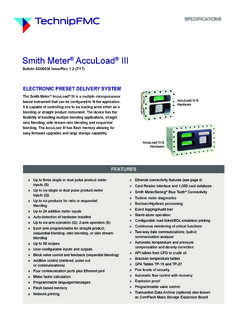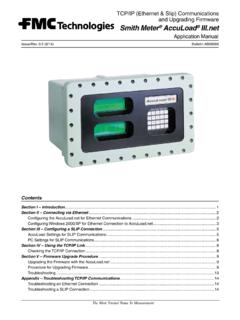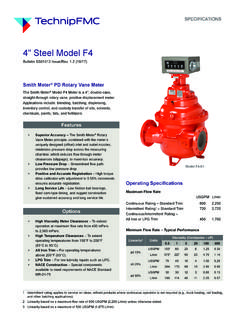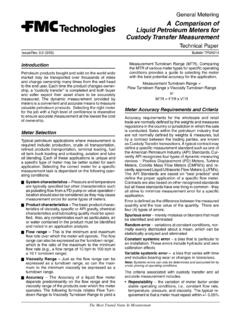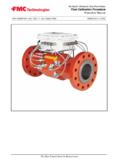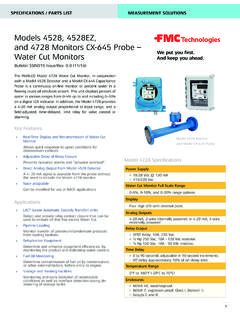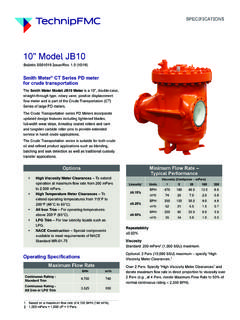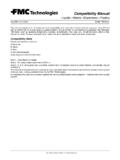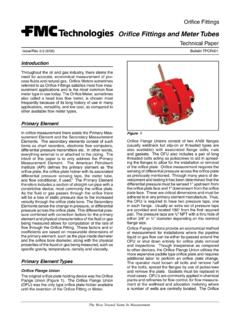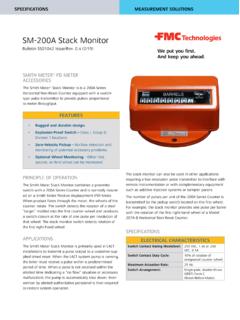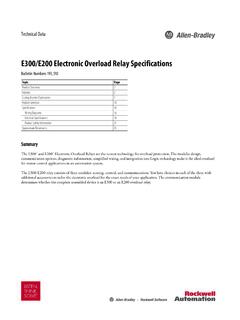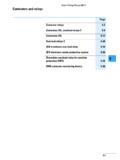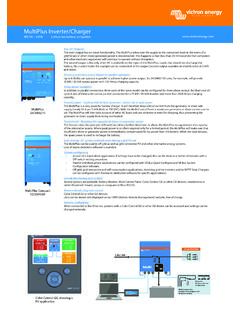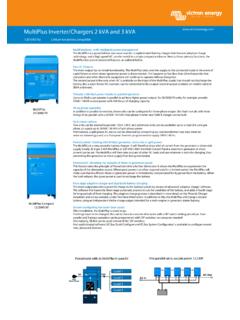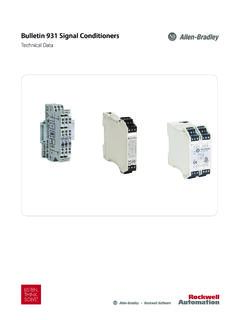Transcription of Smith Meter microLoad
1 SPECIFICATIONS. Smith Meter . Bulletin SS06045 Issue/Rev. (7/17). Electronic Preset Delivery System The Smith Meter is a microprocessor based instrument with Ethernet capability. It is designed to monitor and control single product, straight loading. The unit can operate either as a stand-alone instrument or be part of system where it communicates with an automation or SCADA system. FEATURES. One arm, single product loading and unloading Standalone or remote controlled operation LACT control - BS&W monitoring, Sampler, Diverter Ethernet and serial communications Modbus and Smith communication protocols User authorization database and optional card reader Event, transaction and W&M audit logging User configurable load ticket and display Automatic volume correction of refined/crude liquids from LPG to asphalt based on temperature, pressure and density using API MPMS CH.
2 Tables and all industry standard calculations Applications TechnipFMC Promass Coriolis Meter The microLoad is ideal for any liquid transfer application communications for density and status requiring accurate weights and measures approved Globally W&M and electrical safety approved measurement and precise real-time control. Configurability Built-in web server for browser access has been built-in which allows every aspect of the operation Transaction log export to spreadsheet to be tailored to fit a wide variety of situations. programmable pulse output Refined products Batch loading/unloading of alcohol, Fully programmable flow profile gasoline, lube oils, fuel oils, solvents, fertilizers, LPGs, Optional display back-up per OIML LNGs, and liquid chemicals into trucks, rail cars and barges.
3 Three levels of parameter access security Ideal for bulk plants, shipping docks, processing installations, and tank farms where a single unblended product is Automated proving assistance transferred. Boolean/Algebraic custom logic expressions Crude Oil The microLoad supports loading, unloading Additization of metered or unmetered products and LACT transfers of crude oil with built-in facilities to MicroMate configuration utility included monitor and average BS&W, control a sampler with up to programmable language / messages four sample cans, and full diverter valve control. Refer to Continuous monitoring of critical functions publication AB06100 for additional information regarding Pulse security level B upstream/crude oil applications.
4 Temperature Compensation Additive monitoring provides the capability for the The temperature compensation feature provides the to monitor feedback from the piston injectors customer with the ability to compensate for variance in of the additive products. The monitors the temperature from a reference temperature. This feature injector feedback switches for a change of state and counts is used with an RTD input or a temperature transducer the errors and alarms if no change is detected within the and, excluding the accuracy of the fluid temperature cycle or a period of time, depending on how the unit is measurement, will exactly match the proper volume programmed.
5 The will totalize additive correction factor of ASTM-D-1250-04, and API MPMS volume based on confirmation signals and a programmable CH - 2004 tables as noted below, over the fluid volume per cycle. The totalized volume will print on the temperature range of -58 F to 302 F (-50 C to 150 C). emulated load ticket printed on the printer output. The following API tables can be programmed in the For Smart additives, the firmware has also been designed : 5A, 5B, 5D, 6, 6A, 6B, 6C, 6D, 23, 23A, with a Master/Slave type of communications, with the 23B, 23D, 23E, 24, 24A, 24B, 24D, 24E, 53, 53A, 53B, being the master and the Additive Injector 53D, 53E, 54, 54A, 54B, 54C, 54D, 54E, 59A, 59B, 59D, System being the slave.
6 The constantly 59E, 60A, 60B, 60D, 60E; also BR1A, BR1P, BR2P, and interrogates the Additive Injector System for a change ETH/Gas (PTB), Aromat. in status. The can be operated with communications control over the Smart Additive Injector System or with communication/pulse control. When the Pressure Compensation has communication control over the Pressure compensation provides the customer with the Additive System, it will constantly monitor the Additive ability to compensate the volume of product delivered at System for its status, poll the additive totals, and signal varying pressures per API Tables and , the system when to inject additive all through the using a 4-20 mA pressure transducer input.
7 This feature communications line. also contains real-time control functions for maintaining The communications package has also system pressures at the Meter to a minimally-acceptable, been designed with a pass-through communications mode. user-definable level (pressure transducer not included). In this mode of operation the supervisory computer can Pressure compensation is particularly useful for light talk to the Additive Injector System through communication products, such as LPG, where the compressibility factor lines run to the and from the varies greatly with different pressures. to the Additive Injector System(s). Density Correction Additization of Unmetered Products The density correction feature provides the customer The has a feature that allows it to additize with the ability to correct the volume of product delivered products that do not have a Meter providing pulses on the at varying densities (crude).
8 The microLoad can read main product stream. This feature was added to provide a the line density as a 4-20 mA analog signal or through device to handle the injection of lubricity additive into low communications when using a Promass Coriolis Meter . sulfur diesel where the diesel is not being metered. The has been designed to handle three separate Metered Injectors, Piston Injectors, scenarios for the application: and Smart Additives Scenario 1 With Meter on main product (standard The has been designed to provide maximum method). receives pulses from product Meter flexibility when it comes to additive control. The unit is capa- and paces additive accordingly.
9 Ble of handling metered injectors, piston injectors and smart Scenario 2 Flow switch on main product line (no Meter ). additives simultaneously. No Meter on the main product; the will simu- The is capable of controlling four additive late pulses. These pulses will be generated to match the injector systems. (One metered injector and three piston or selected high flow rate. Thus, the additive will be paced Smart or zero metered injectors and four piston or Smart.) according to the predicted flow rate rather than The controls the additive solenoids of the actual flow. metered injectors to precisely inject additive into the main Scenario 3 No flow switch or Meter on main product.
10 It monitors the pulses of the additive Meter and will start simulating pulses when the START. controls the amount of additive, based on the incoming key is pressed; thus, an operator must be present. Similarly, pulses from the additive Meter and main product Meter . the batch preset size must be accurate as the addization will be done over the entire preset amount. 2 Bulletin SS06045 Issue/Rev. (7/17). Dual Pulse Security Communications This feature provides continuous monitoring and error The is equipped with three standard indication alarm of pulse transmission for each preset programmable communication ports that can be set up position per API Petroleum Measurement Standard, to be either EIA-232 or EIA-485 compatible communication Chapter , Level B, and Institute of Petroleum Standard, ports, with baud rates up to 38,400 bps.
